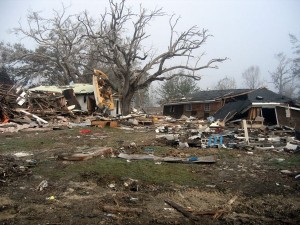This is the second part to a series about Hurricane Katrina.
Please read the previous blog “X marks the spot” to read the first part of this series.
USA TODAY ranked the story of Hurricane Katrina 4th place in their “25 Headlines that shaped History”
Other nations couldn’t help but acknowledge the devastation. Some headlines from September, 2005:
China Morning Post: “Dollar Dives Amid Katrina Chaos” — The U.S. dollar dropped to a three-month low point against the euro on Friday, faltering as the devastation wreaked by Hurricane Katrina threatened to cripple growth in the world’s largest economy.
TF1 TV(France): It’s unusual for the United States, the number one economic and military superpower in the world, to ask for international help for a domestic catastrophe. The last time this occurred was after the September 11 attacks.
Die Welt(Germany): America looks aghast at a third world situation on its own soil, splintered and full of violence.
The Australian: “Forgotten Biloxi Belts Out the Blues” –The slow drive towards Biloxi is like glimpsing the post-oil future, a 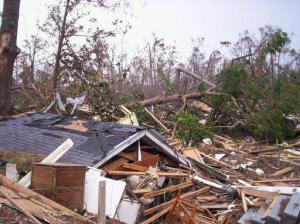 scene out of the post-apocalyptic movie Mad Max.
scene out of the post-apocalyptic movie Mad Max.
12 hours had passed almost to the minute before Katrina finally allowed us to step outside our safe haven. It was 5:00 in the afternoon and the sun broke through the clouds and shone down on what appeared to be the aftermath of nuclear war. We were stunned and speechless…and thankful when we looked back on the house we were in. Large trees were scattered like match sticks all around the house, having barely missed it. Most of the roof was intact and damage was minor. We looked out to the street and among the scattered debris people began to emerge. Everyone appeared to be in a zombie like state. We focused on a couple who’s clothes were tattered and torn and they were bloodied and bruised. We offered them help and listened to their story of how they’d swam for their lives from a home that was washed away in the surge of water just a few blocks away. They swam for about 8 hours as they recalled. I get goose bumps remembering this conversation. – Suz 8/26/10
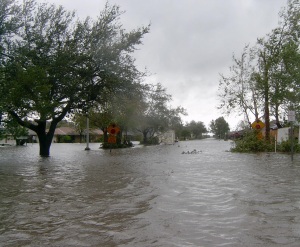 From “Quarrelling through Katrina” on msnbc.com:
From “Quarrelling through Katrina” on msnbc.com:
Hurricane enthusiast George “Sonny” Hoffman found himself in the company of an unlikely group of strangers when he went to Waveland, Miss., to meet Hurricane Katrina. Sonny believed the group was in a world of trouble and appointed himself commander. As he tells it, he began formulating plans and back-up plans. Sonny was alone in his belief that the Texan Motel, a mile and a half from the waterfront, would flood. He predicted the storm surge would reach 20 feet on Highway 90 and 7 feet at the hotel.
“Everyone had the sense of relief that when the sun came up that you know — it was over, you’d made it through the night,” says Colleen, even though the wind was still blowing. It was only then that Katrina brought the deluge.
As Sonny remembers it: “It was Robert who brought it to my attention that the parking lot across the street was filling up with water. It had become a lake, the cars were floating. Their lights were on. Then we notice that there’s a river flowing down Highway 90. It looked like the Colorado River.”
Colleen describes it this way: “I walked out to the street to see if I could see anything. And that’s when the wave (came). … It looked like somebody ought to be surfing on it. It had a white cap. … I would have expected a parade of pink elephants before I would have expected this huge wave coming down Highway 90.”
From “Hurricane Katrina: Survivor Stories” on CTVnews:
“We grabbed a lady and pulled her out the window and then we swam with the current. It was terrifying. You should have seen the cars floating around us. We had to push them away when we were trying to swim.”
Schovest lived at Quiet Water Beach apartments in Biloxi, Miss., where authorities estimate 30 people perished.-Joy Schovest
Just a few months prior to Katrina I had found myself in a very good position in life. I was poised to begin a new endeavor in property management. My quaint little cottage just a couple of blocks away from the beautiful Waveland beach front had raised in value dramatically. I’d remodeled it somewhat and transformed it from an outdated camp style home to an attractive and inviting cottage style home. I was in a position to move forward, using that home as a propeller toward bigger and better things. With a good paying job, money in the bank, the humble beginnings of a classic car collection and a valuable home I was able to take a loan against these items and purchase a bigger, better home (under the agreement that my cottage would be rented on a regular basis and the classic cars would be rebuilt and re-sold for profit). I had moved most of my belongings into my beautiful new home, only about 3 miles from my cottage and was aimed for success. I got a pretty decent deal on the new home and envisioned it turning more profit and becoming a land lord of sorts. I had dreams. The cottage was emptied except the garage full of antiques, collectables, and childhood memories stored in boxes I just hadn’t found the time to move to my new house yet. The new house was still cluttered with boxes full of valuables, particularly my music memorabilia such as collectable items, autographs and photographs. It was too much work to sort through it all, so I kept it stored in the recreation room at the new house out of the way until I could find the time. When thinking of material things, it was a bit ironic that everything I had stored at that cottage and in boxes in the new house happened to be the most important and irreplaceable of all my personal belongings in life … and the only items that were lost in Katrina. During the storm, in that fateful moment that I stepped down into the recreation room and noticed it flooding it didn’t even dawn on me that I should quickly start gathering my valuables and move them to higher ground. I guess I was in too much of a state of shock.
I never dreamed I would need to cover my property for flooding. It didn’t seem fathomable. The cottage was 13 feet above sea level and had braved many hurricanes in it’s nearly 40 year life span. The bank didn’t require flood insurance and the insurance company didn’t recommend it. Of course, it was close to the beach so I wouldn’t have seen it as a safe place to stay simply because of the wind. Besides, I had a new home at least a mile north of the cottage that was deemed hurricane proof by the seller. And, I have to say, that turned out to be pretty true thankfully.
Christian’s house was not far from the cottage. After helping a few people we met on the street, we noted that while we still had at least 3 hours of daylight left we should venture to our other properties and survey the damage. We hopped on our bicycles for what would normally be a 15 minute journey and rode into a 3 hour adventure were we would struggle with obstacles and find ourselves carrying those bikes over our backs while trudging through heavy debris more often than we were able to ride them. We had no idea what we were in store for…-Suz 8/27/10
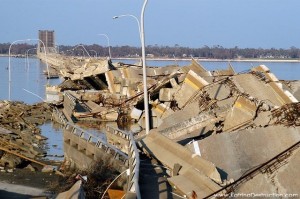
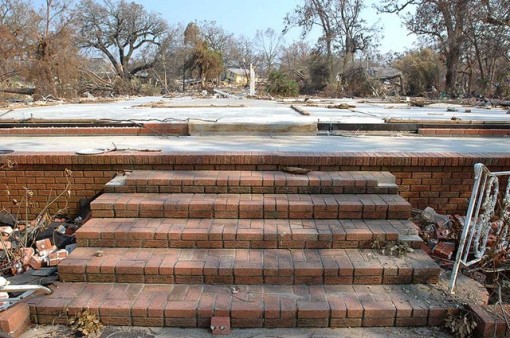
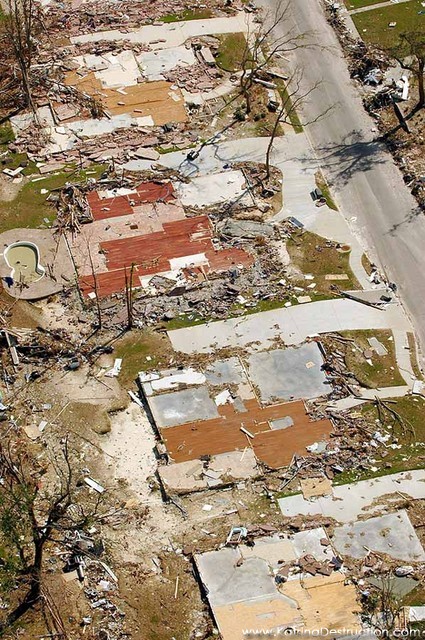
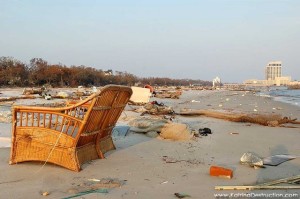 As I explained in “X marks the spot”, this series will continue for the next few days honoring the 5 Year Anniversary of Hurricane Katrina. Please visit again. Thank you.
As I explained in “X marks the spot”, this series will continue for the next few days honoring the 5 Year Anniversary of Hurricane Katrina. Please visit again. Thank you.
Suz

